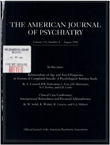Quantitative morphology of the caudate nucleus in attention deficit hyperactivity disorder
Abstract
OBJECTIVE: Because the caudate nuclei receive inputs from cortical regions implicated in executive functioning and attentional tasks, caudate and total brain volumes were examined in boys with attention deficit hyperactivity disorder (ADHD) and normal comparison subjects. To gain developmental perspective, a wide age range was sampled for both groups. METHOD: The brains of 50 male ADHD patients (aged 6-19) and 48 matched comparison subjects were scanned by magnetic resonance imaging (MRI). Volumetric measures of the head and body of the caudate nucleus were obtained from T1-weighted coronal images. Interrater reliabilities (intraclass correlations) were 0.89 or greater. RESULTS: The normal pattern of slight but significantly greater right caudate volume across all ages was not seen in ADHD. Mean right caudate volume was slightly but significantly smaller in the ADHD patients than in the comparison subjects, while there was no significant difference for the left. Together these facts accounted for the highly significant lack of normal asymmetry in caudate volume in the ADHD boys. Total brain volume was 5% smaller in the ADHD boys, and this was not accounted for by age, height, weight, or IQ. Smaller brain volume in ADHD did not account for the caudate volume or symmetry differences. For the normal boys, caudate volume decreased substantially (13%) and significantly with age, while in ADHD there was no age-related change. CONCLUSIONS: Along with previous MRI findings of low volumes in corpus callosum regions, these results support developmental abnormalities of frontal-striatal circuits in ADHD.
Access content
To read the fulltext, please use one of the options below to sign in or purchase access.- Personal login
- Institutional Login
- Sign in via OpenAthens
- Register for access
-
Please login/register if you wish to pair your device and check access availability.
Not a subscriber?
PsychiatryOnline subscription options offer access to the DSM-5 library, books, journals, CME, and patient resources. This all-in-one virtual library provides psychiatrists and mental health professionals with key resources for diagnosis, treatment, research, and professional development.
Need more help? PsychiatryOnline Customer Service may be reached by emailing [email protected] or by calling 800-368-5777 (in the U.S.) or 703-907-7322 (outside the U.S.).



